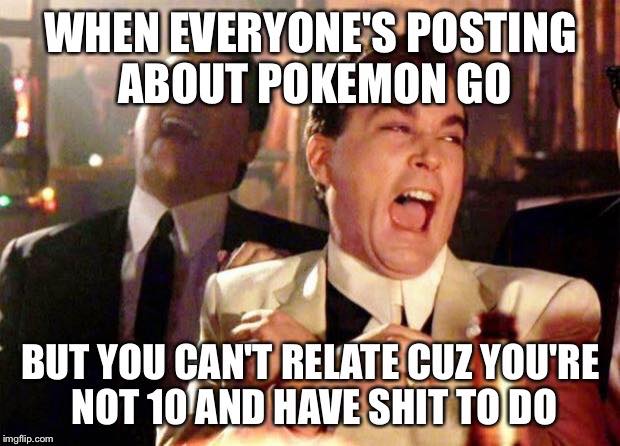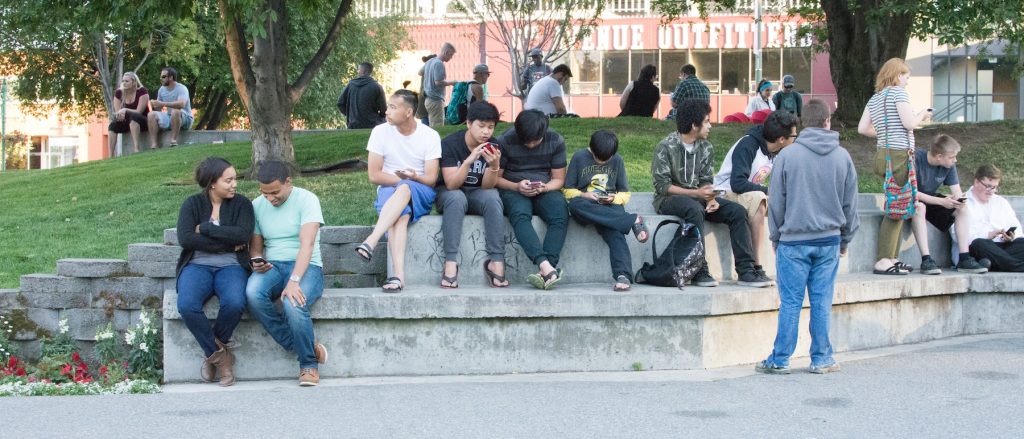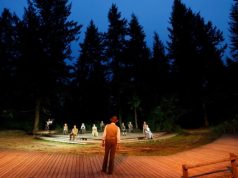I really want to play Pokémon GO.
The augmented reality game was released on July 6th in the United States, Australia and New Zealand and, as of July 13th was a more popular use of the internet than searching and viewing porn. It has more active viewers daily than Twitter and Tinder. As of July 13th, that’s 9.5 million daily active users. This is big.
The game is essentially a scavenger hunt where players collect creatures or items that will increase their success at capturing creatures. And the creatures evolve into more valuable versions in relation to the distance players walk.
Instead of doing this in an imagined, on-line world, Pokémon GO transposes game play onto the real world using augmented reality. Players, or “trainers”, are guided by a map to travel their real-life bodies to real-life locations where they pan their smartphones around in the hopes of catching a glimpse of a charmander or spearow.
Theatre is the original augmented reality. We take the darkened room, which we all agree is merely a darkened room, insert imagined figures, and push those figures to compete, help, or hinder each other.
This is the kind of theatre that I love, the kind that never asks you to believe for even one second that the stage is not a stage. The theatre that tickles the brain by inhabiting the real world and the fictive world at the same time. Unapologetically.
Last week, while walking through the Boston Commons I passed a cluster of three young men, smartphones at the ready. “Pokémon Go!” I whispered to my travel companion. “How can you tell?” he asked.
It was a combination of things: their out-of-placeness, steaming in the humid heat; the smartphones present but not in use at the moment, no photos or texting or instagramming happening. But there was also an air of adventure, that they were like the kids in Goonies, on the hunt for something good.
This is what attracts me most to the game: the possibility that it will bring individuals out of their homes and offices into the streets to engage with the city as pedestrians. Some might argue Pokémon GO players are not really engaging with the city because they are focused on a screen. But they are still moving outside of the day-to-day routine, and once out of the day-to-day, well, anything can happen. Just ask the players who’ve found dead bodies (yes, more than one). Or the “trainers” who’ve conquered crippling social anxiety and managed to leave the house to capture magikarps.
If you watch the news at all, the city streets – especially in the US, especially if you are not white – have never seemed more dangerous. And yet thousands of people are wandering the city and not really paying attention. Is there an assumed sense of safety because one can’t really get hurt in a video game, even if one’s avatar loses all its heart points? That is the confidence that opportunists who lure Pokémon trainers to isolated locations are counting on.

And we mustn’t forget that not everyone is playing Pokémon Go. As Mary Flanagan writes in Critical Play: Radical Game Design, participants in locative games in public space often come from specific socio-economic classes, those with enough resource to own a smartphone with a significant data plan and battery power, and considerable leisure time.
Ultimately, players of Pokémon GO are taking on roles and those roles are emboldening, inspiring, and driving them to action. The city is no longer the site of day-to-day transactions and travel: it is now the setting for adventure. As gamers move away from static positions locked to screens and into physical intervention in the real world, their role expands from player to performer. They are performing actions, interacting with other players, and – knowingly or not – are watchable. And trust me, you’re being watched (unless you’re Justin Bieber).
Beyond directly participating, bystanders are also implicated in the performance of Pokémon GO.
I think the men I saw in Boston were Pokémon trainers, but they may not have been. But it doesn’t matter, because the possibility was activated within my imagination. So without even having engaged in the work-around necessary to download the game to my Canadian phone, I’m already playing. I may not be looking for whatever those birds are called, but I’m looking for those who are looking for them. My attention to my surroundings is heightened, and especially to anyone wielding a smartphone.
I’m an audience in search of a performance.
My travel companion remarked that Pokémon GO has rendered iconic the physical gestures associated with playing the game. In the same way that bringing an object to one’s ear reads as “phone”, now scanning the environment with a smartphone reads as “Pokémon”.
There have been augmented reality apps before Pokémon GO and there will be more to come, but this particular one has tipped the scales into mega-popularity. The game-play not only taps into our innate drives to collect things and WIN, but also popular cultural nostalgia – and those pokémons are so cuuuuuute.
Theatre makers dream of this level of public engagement and of breaking into popular consciousness so thoroughly. I’d be satisfied with a fraction of the participants, a tiny slice.
The success of Pokémon GO is more than what David Shields calls reality hunger, the collective desire for real stories exemplified by This American Life, reality television (however deftly edited), verbatim theatre, documentary theatre, and the slew of “this is my story” one-person-shows.
Pokémon GO is engagement with the real in search of the imagined. It is a role-playing game that brings together the dual identities so many of us occupy: our on-line and real-world selves.
The game provides the elements of drama: setting, conflict, and an evolving quest-narrative that motivates the players, each one the protagonist of their story.
For their part, the players have everything actors need to play a role: a character (or avatar), an objective (collect and evolve your ménage-à-pokémon), and obstacles (other players and navigating the city itself).
The game is a fluid, on-going performance not only for those engaged in playing on their mobile phones, but also for those of us watching from the sidelines in real life and on the web.










